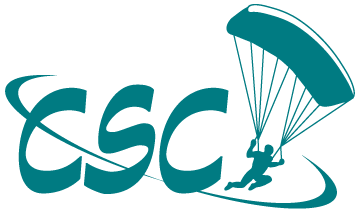First-time skydivers are always asking if it’s common to get motion sickness or nauseous mid-air. They worry they may need to use the onboard bathroom or even feel queasy mid-jump, so they seek ways to calm their nerves before taking the leap of faith.
In this post, we’re here to address the possible “sick” feelings you could have before the big jump or during the descent — explaining why some skydivers experience more bodily reactions than others and how you can avoid the pre-jump jitters and truly enjoy your freefall!
Skydiving Itself Doesn’t Cause Motion Sickness
That’s right: you read that correctly. The act of skydiving itself doesn’t usually cause motion sickness. Here’s why.
Many people automatically associate skydiving with that classic rollercoaster, stomach-dropping experience when, in fact, the two activities are very different. On a rollercoaster, you’re typically creeping slowly to the top of the “hill” before coming to almost a complete stop at the top and then plummeting down. In this way, you go from a slow speed to a fast jolt, near instantly. This shock-factor is what makes riding coasters a thrillseeker’s paradise, however, skydiving is not quite so “zero to nothing.”
From the moment you leave the ground, the airplane is in constant motion. By the time you ascend to the perfect jump height, the aircraft is moving close to 100 mph. When you jump, you’re freefalling at roughly 120 mph, so the speed shock isn’t nearly as stark. In this way, you don’t experience the same kind of stomach drop you might expect while plunging on a coaster. Between the rushing wind and the beautiful clouds and scenery around you, there are plenty of other things on your mind than your stomach mid-skydive.
It’s in the Airplane That People Have Symptoms — Not During the Freefall
The people who do experience stomach issues or feelings of motion sickness often do so in the aircraft on their way up to the jumping point. This stomach flipping or lightheadedness is often a combination of nerves for the big freefall, as well as a change in elevation.
The higher up the aircraft ascends, the more likely it is for the air pressure difference to cause your ears to pop and your equilibrium to feel “off.” As a result, sometimes first-time skydivers can experience a wave of nausea right before the plane adjusts to peak elevation. Give it a few minutes. Once the aircraft is “even” and flying at a constant speed, the sick stomach or wooziness should soon pass.
Tips for Avoiding Feeling Sick Skydiving
Still not feeling confident you can skydive without getting sick? Avoid nausea and panic attacks with this advice, straight from the skydiving pros:
1. Eat a normal portioned, healthy meal pre-jump.
Most first-time skydivers have those pre-jump jitters and butterflies in their stomach. As a result, they don’t feel hungry. They think, “I’ll eat after I skydive.” Unfortunately, not eating prior to the jump can make you feel lightheaded. Remember, food gives you the energy you’ll need to enjoy the skydiving experience without being “hangry.”
Don’t go to an all-you-can-eat buffet before a skydive; just eat a regular healthy meal without overstuffing. No greasy, fatty platters that would make anyone a little queasy. Even when you aren’t skydiving, that too-full, heavy feeling is no fun. Should you decide to eat a tad lighter than usual to play it safe, you can stop by our Flight Deck Bar & Grill for a bite after your freefall.
2. Hydrate, hydrate, hydrate!
Some worry that they’ll have to go to the bathroom mid-flight and avoid liquids before skydiving. Hydrating before the jump, however, is very important. Like eating, this will help to keep that lightheaded feeling or acidic stomach at bay. Now, we don’t mean chugging a bottle of water right before the jump, which could get your tummy in twists and put unnecessary strain on your bladder. Instead, properly hydrate a few hours before the jump.
Rest assured that after the pre-jump training session, we always let our freefallers use the restroom before gearing up to board the plane. All-in-all, most skydiving experiences are no more than an hour from the time you gear up to when you are back on the ground, so we have confidence that you can hold it!
3. Absolutely no alcohol.
What’s the opposite of hydrating? Drinking alcoholic beverages. Many think that a strong shot or a few beers will calm them down prior to skydiving. Really, they often just end up causing an unsettled stomach or nausea on the plane or descent.
We advise avoiding alcohol for at least 8 hours prior to jumping and definitely avoiding coming to our skydiving center with a hangover. After a heavy night of drinking, your stomach and head are already under stress trying to recover; skydiving aside, it’s hard doing anything hungover.
4. Remember to breathe.
Oftentimes first-timers feel short of breath or lightheaded on the plane ride up because they are nervous and not breathing mindfully. They get themselves worked up and take shallow breaths.
When ascending to between 8,000-18,00 feet (depending on your jump height of choice), it’s important to realize your body is acclimating to the elevation difference. The higher up you go, the “thinner” the air will feel. Taking deep, focused breaths will help you slow down that racing heart rate and settle your nerves.
Prepare for Your Big Jump with CSC
Knowing how to diminish the feeling of motion sickness and stomach problems when skydiving is a great way to push past the nerves and really focus on enjoying the excitement of the experience.
In our Tandem Skydiving Guide, we offer more tips and tricks for first-time freefallers to take the plunge with confidence. Download the free guide today.


